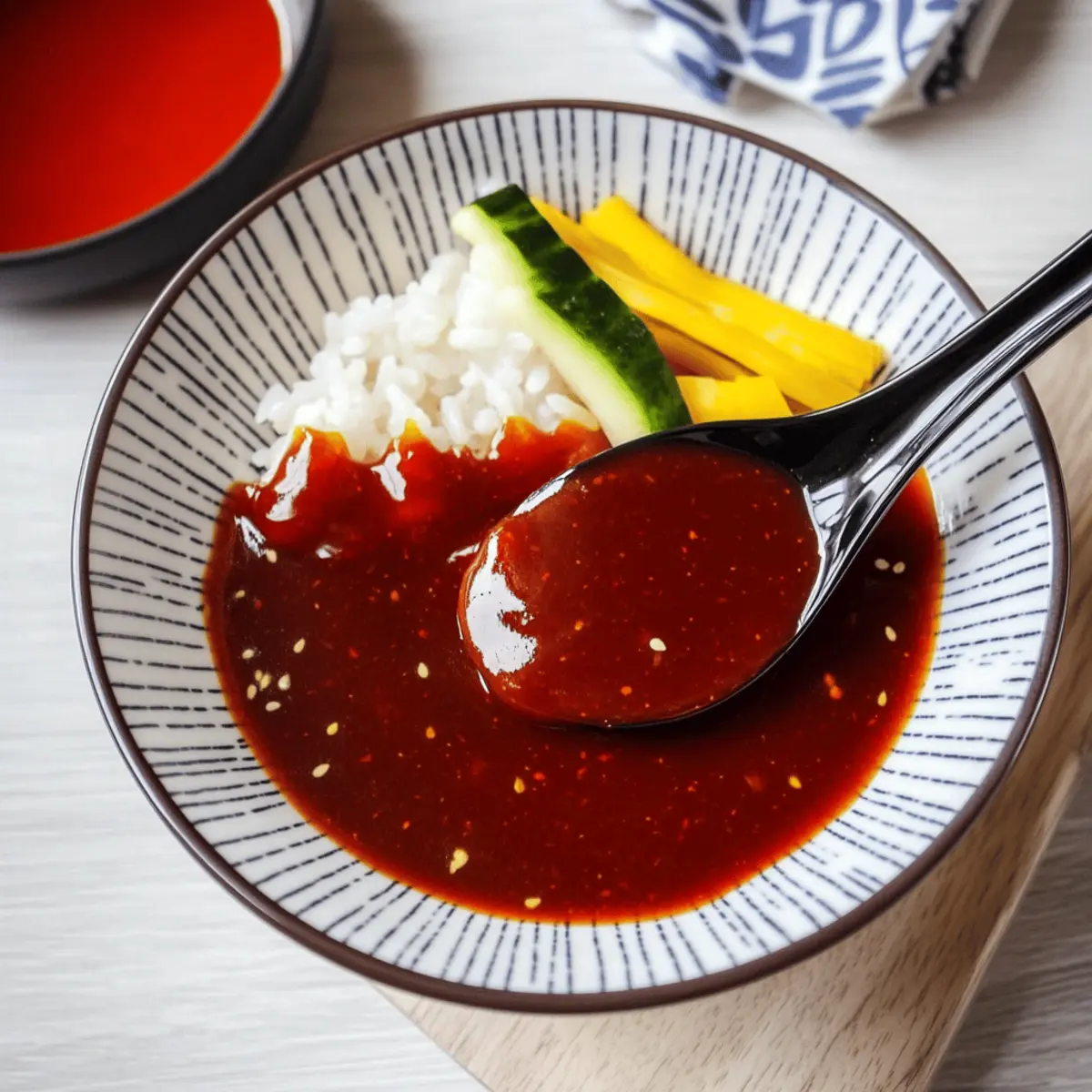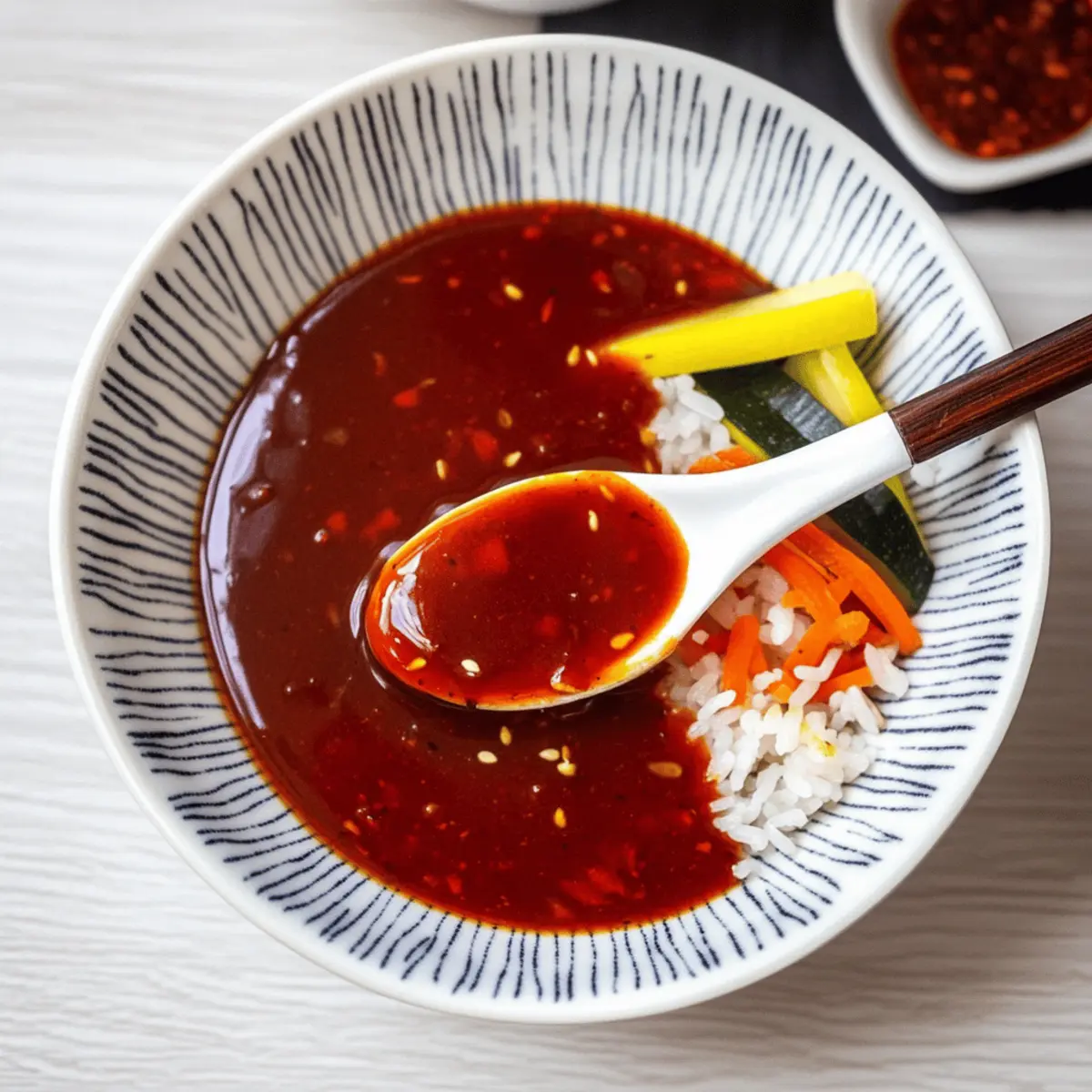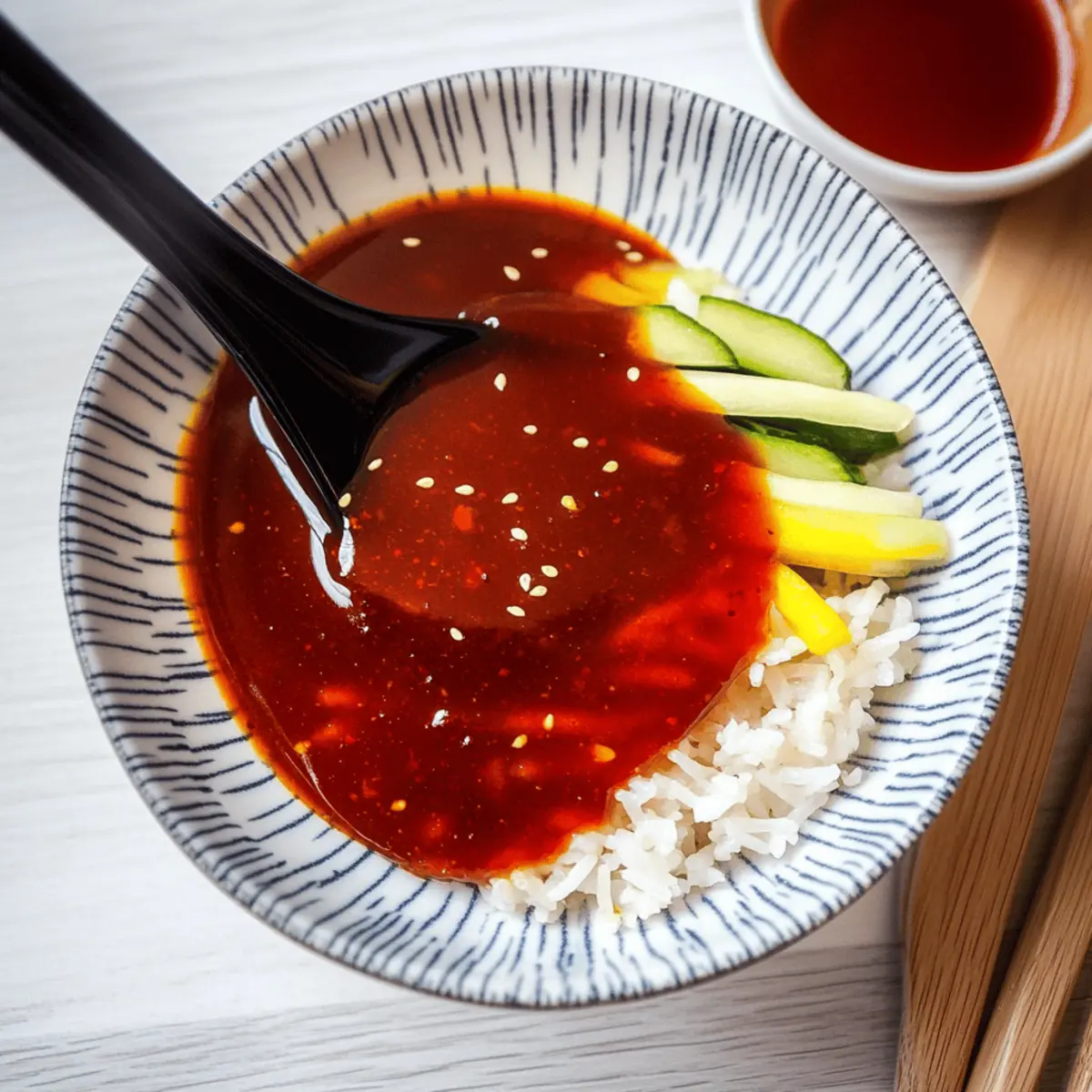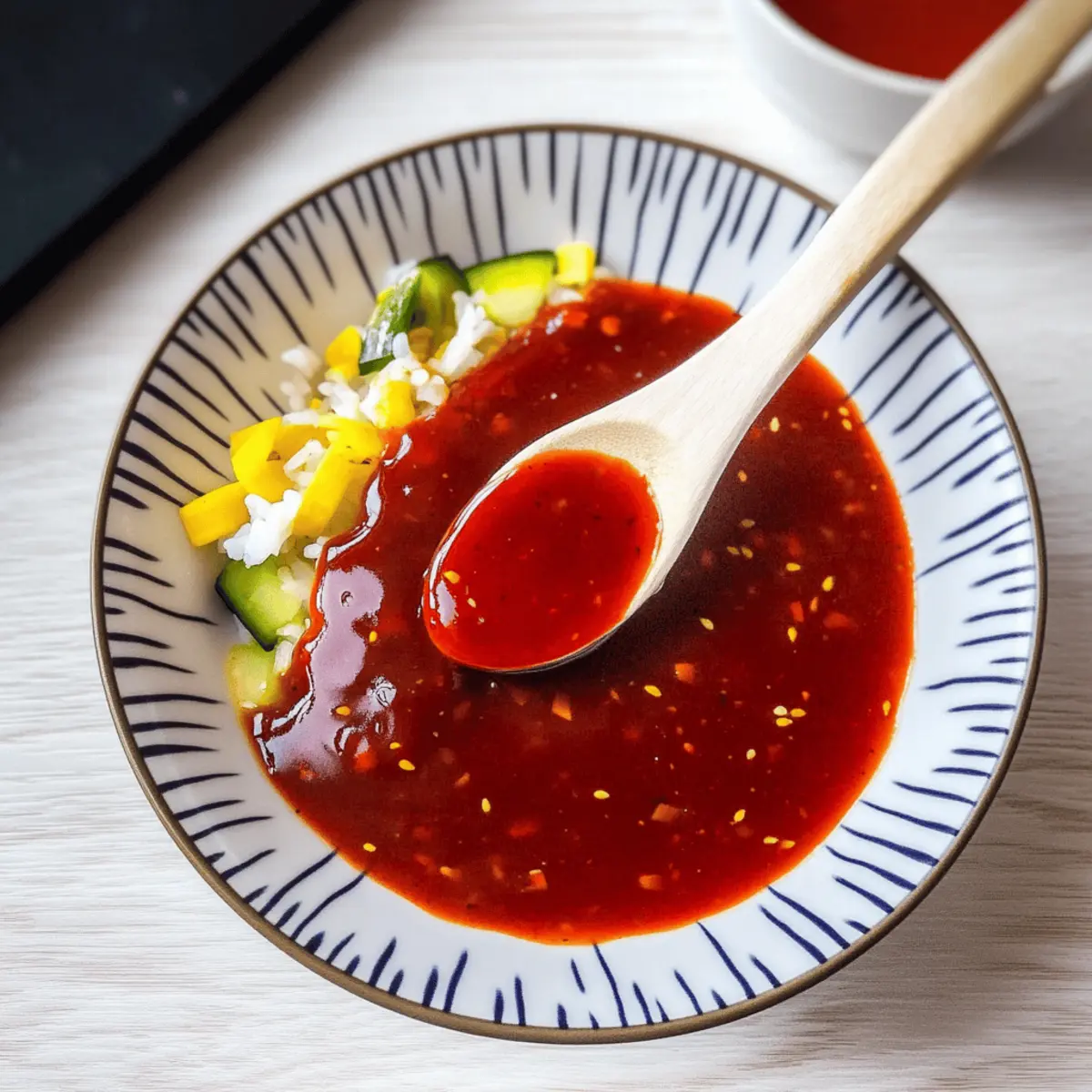A delightful explosion of colors and flavors awaits with this homemade Bibimbap Sauce! In just five minutes, you can whip up this delectable blend of spicy and sweet Korean goodness, which elevates any rice bowl and takes your taste buds on a savory journey. With the power to customize the spice level, it’s perfect for both heat-seekers and those who prefer a gentler touch, making it a fantastic addition to your repertoire. Plus, it’s vegetarian and made from only six simple pantry ingredients—ideal for busy weeknights or impressing friends at a dinner party. Will you dare to dive into the world of bibimbap, or will you play it safe with a mild twist? Let’s find out!

Why is Bibimbap Sauce Amazing?
Quick Preparation: You can whip this sauce up in just five minutes, making it a perfect solution for busy weeknights or last-minute meal prep.
Customizable Heat: With adjustable spice levels, it appeals to both spice novices and enthusiasts. Add more gochujang for a fiery kick!
Versatile Applications: Perfect for drizzling over grilled proteins, vegetables, or even as a dipping sauce, this bibimbap sauce enhances any dish.
Vegetarian-Friendly: Made with simple, vegetarian ingredients, this sauce caters to various dietary preferences without compromising flavor.
Pantry Staples: Utilizing just six common ingredients means you can keep the momentum going in your kitchen without running to the store! Get ready to transform your meals with the bold, compelling taste of this bibimbap sauce.
Bibimbap Sauce Ingredients
• Enjoy the simplicity of just six ingredients to create this flavorful bibimbap sauce!
For the Sauce
- Gochujang – a fantastic base offering signature spiciness and depth; adjust according to your preferred heat level.
- Garlic, minced – adds a deliciously pungent flavor; fresh garlic yields the best taste.
- Toasted sesame oil – contributes rich, nutty flavor; regular sesame oil can be used for a milder option.
- Honey – balances the heat with sweetness; agave nectar works as a vegan substitute.
- Sugar – enhances sweetness; optional based on your taste preference.
- Rice vinegar – brings acidity and brightness; can be swapped with apple cider vinegar if needed.
- Salt (optional) – enhances flavor, but use sparingly since gochujang is already salty.
Embrace the vibrant flavors of bibimbap sauce with these pantry staples, and feel free to customize it to your liking!
Step‑by‑Step Instructions for Bibimbap Sauce
Step 1: Combine Ingredients
In a medium-sized mixing bowl, combine 2 tablespoons of gochujang, 1 tablespoon of minced garlic, and 2 tablespoons of toasted sesame oil. Next, add 1 tablespoon of honey and 1 teaspoon of sugar for sweetness. Finally, pour in 1 tablespoon of rice vinegar, and if desired, a pinch of salt to taste.
Step 2: Mix Thoroughly
Using a whisk or a fork, mix the ingredients vigorously until well integrated, ensuring there are no lumps. The bibimbap sauce should achieve a smooth and glossy consistency, indicative of well-blended components. This step typically takes only 1 to 2 minutes, but it’s crucial for an even flavor throughout the sauce.
Step 3: Adjust for Spice
Taste the sauce to assess the spice level and sweetness. If you prefer a bolder heat, feel free to add an extra teaspoon of gochujang. Alternatively, for a milder flavor, reduce the amount of gochujang and incorporate a little more honey or sugar to balance it. This allows you to customize the bibimbap sauce to your liking.
Step 4: Serve or Store
Once satisfied with the flavor, you can either serve the bibimbap sauce immediately or transfer it to a glass jar for storage. This sauce can complement your favorite bibimbap dishes and is kicky right out of the bowl. If storing, seal tightly and keep in the refrigerator; it’ll stay fresh for up to 2 weeks.
Step 5: Enjoy Versatile Uses
Utilize your bibimbap sauce as a delightful drizzle over grilled proteins or fresh vegetables, or even as a zesty dipping sauce for appetizers. The versatility of this sauce enhances a variety of dishes, ensuring that each meal bursts with flavor. Happy cooking!

Expert Tips for Bibimbap Sauce
• Spice Adjustment: Start with a small amount of gochujang, then gradually add more if you prefer increased heat in your bibimbap sauce.
• Storage Guidance: Always opt for a glass container for storing the sauce; it prevents staining that plastic can experience from gochujang.
• Freshness Matters: Use freshly minced garlic for a more vibrant flavor in your bibimbap sauce; powdered garlic lacks that essential punch.
• Taste Testing: Don’t be afraid to taste your sauce as you prepare it; adjusting sweetness or spice levels allows you to create a personalized flavor profile.
• Ingredient Creativity: Feel free to swap ingredients based on availability; for instance, apple cider vinegar works just as well as rice vinegar in this bibimbap sauce.
What to Serve with Quick and Easy Bibimbap Sauce
Elevate your meals with these delightful pairings that perfectly complement the bold flavors of this Korean-inspired sauce.
- Steamed Jasmine Rice: A fluffy base that absorbs the vibrant flavors, making each bite a delightful harmony of taste.
- Grilled Vegetables: The charred sweetness of seasonal veggies adds a lovely crunch, balancing the sauce’s spiciness with a smoky undertone.
- Crispy Tofu: With a golden crust and soft center, tofu takes on the bibimbap sauce beautifully, offering a satisfying protein option.
- Sesame Noodles: Their nutty taste is a perfect counterpoint to the sauce’s kick, turning a simple meal into an Asian-inspired feast.
Consider tossing some sautéed greens or bean sprouts alongside your bibimbap for added freshness and texture.
- Korean Kimchi: This fermented side adds a zesty, tangy depth that beautifully complements the sauce’s sweet and spicy notes.
- Sichuan Peppercorn Chicken: The bold, numbing spice of this dish pairs excellently with the bibimbap sauce, creating a fusion of flavors.
- Mango Salad: A cool, refreshing burst of sweetness from juicy mangoes can balance the heat while introducing a lively, fruity element to the table.
Bibimbap Sauce Variations & Substitutions
Feel free to let your creativity flow and customize this bibimbap sauce to perfectly suit your taste buds!
-
Heat Control: Adjust the amount of gochujang for a milder or spicier sauce. For a slight twist, introduce a bit of sriracha to amp up the heat without overwhelming the flavor.
-
Sweet Soy Sauce: Replace honey with sweet soy sauce for an umami-packed sweetness and deeper flavor. This alternative works wonders for a different layer of taste.
-
Vegan Option: Substitute honey with agave nectar or maple syrup to make the sauce entirely vegan without losing the sweet balance.
-
Savory Miso: Add a teaspoon of miso paste alongside the gochujang for a richer, savory depth that pairs perfectly with the nutty sesame oil.
-
Citrus Zest: Try a splash of fresh lime or lemon juice in place of vinegar for a vibrant citrus note that brightens the sauce even further.
-
Extra Garlic: Feel free to increase the minced garlic for a punchier, aromatic kick. This variation is perfect for garlic lovers!
-
Honey Mustard Twist: Incorporate a dash of honey mustard to the mix for a unique blend of flavors that can elevate your bibimbap bowl to new heights.
-
The Sauce Pairing: This bibimbap sauce isn’t just for rice bowls; drizzle it over grilled chicken or shrimp, or use it as a zesty dipping sauce for fresh veggies or even with an exciting Chicken White Sauce for a balanced dish that appeals to a crowd.
Feel free to explore these variations and find your unique flavor profile—your homemade bibimbap sauce is just the beginning of a delicious adventure!
Make Ahead Options
These Bibimbap Sauce preparations are perfect for meal prep enthusiasts and busy home cooks! You can mix the ingredients up to 24 hours in advance. Just combine 2 tablespoons of gochujang, 1 tablespoon of minced garlic, 2 tablespoons of toasted sesame oil, and the rest of the ingredients as outlined in the recipe. When ready to serve, give the sauce a good stir to regain its smooth consistency, as some settling may occur. To maintain quality, store it in a sealed glass jar in the refrigerator, where it will stay fresh for up to 2 weeks. This way, you’ll have your delicious bibimbap sauce ready to elevate any meal with minimal effort!
Storage Tips for Bibimbap Sauce
Fridge: Store the bibimbap sauce in a glass jar with a tight-sealing lid for up to 2 weeks, ensuring its freshness and vibrant flavors remain intact.
Freezer: For longer storage, freeze the sauce in an airtight container for up to 3 months. Thaw in the fridge before use for best texture.
Reheating: If you prefer your sauce warmed, gently heat it in a saucepan over low heat, stirring until warmed through. Avoid boiling to maintain texture and flavor.
Avoid Staining: Always use glass for storage, as gochujang can stain plastic containers, impacting the look of your bibimbap sauce.

Bibimbap Sauce Recipe FAQs
How do I choose the right gochujang?
When selecting gochujang, look for a vibrant red color and a smooth consistency, indicating quality. Check the ingredients for authenticity—pure gochujang should primarily contain chili powder, glutinous rice, fermented soybeans, and salt. I recommend trying different brands to discover which flavor profile you prefer.
How long can I store bibimbap sauce?
You can store bibimbap sauce in a glass jar in the fridge for up to 2 weeks. Make sure to keep it sealed tightly to retain its freshness. If it smells off or changes color, it’s best to discard it and make a new batch!
Can I freeze bibimbap sauce?
Absolutely! For longer storage, freeze the bibimbap sauce in an airtight container for up to 3 months. To thaw, simply place it in the refrigerator overnight. If you notice separation, give it a gentle stir, and it’ll be just as delicious as freshly made!
What should I do if my bibimbap sauce is too spicy?
If your bibimbap sauce turns out too spicy, don’t worry! You can mellow out the heat by adding more honey or sugar to balance it. Additionally, incorporating a splash of rice vinegar can help tone down the spice level. Gradually add these ingredients until you reach the desired flavor.
Is bibimbap sauce suitable for vegans or those with allergies?
Yes, bibimbap sauce can easily accommodate various dietary preferences! For a vegan version, substitute honey with agave nectar. If you have soy allergies, ensure that your gochujang is soy-free, as some brands may include it. Always read the labels to make sure the ingredients align with your dietary needs.
How can I customize the sweetness of my bibimbap sauce?
Customizing the sweetness is simple! Start with the honey or sugar amounts indicated, then taste the sauce as you make it. If you prefer a sweeter sauce, add more honey or sugar gradually, mixing well after each addition. This hands-on approach ensures you create the perfect balance that suits your palate!

Delicious Bibimbap Sauce: Customize Your Perfect Spice Level
Ingredients
Equipment
Method
- In a medium-sized mixing bowl, combine 2 tablespoons of gochujang, 1 tablespoon of minced garlic, and 2 tablespoons of toasted sesame oil.
- Next, add 1 tablespoon of honey and 1 teaspoon of sugar for sweetness. Finally, pour in 1 tablespoon of rice vinegar, and if desired, a pinch of salt to taste.
- Using a whisk or a fork, mix the ingredients vigorously until well integrated, ensuring there are no lumps.
- Taste the sauce to assess the spice level and sweetness. Add more gochujang for a bolder heat, or more honey/sugar for a milder flavor.
- Serve the bibimbap sauce immediately or transfer it to a glass jar for storage.
- Utilize your bibimbap sauce as a drizzle over grilled proteins or fresh vegetables, or as a dipping sauce.

Leave a Reply